Feedback and Reflective Learning: Enhancing Assessment in Education
VerifiedAdded on 2023/06/10
|8
|2154
|297
Report
AI Summary
This report examines the role of reflective learning in higher education, emphasizing the importance of feedback and feedforward in improving student performance. It discusses reflective learning models like the Gibbs model and their application in analyzing experiences and learning from them. The report highlights how feedback, both formative and summative, along with feedforward, guides students to enhance their skills and achieve their academic goals. It also explores the relationship between feedback and formative/summative assessments, noting how effective feedback helps teachers tailor their instruction to meet student needs and improve overall learning outcomes. The document concludes that reflective learning, combined with constructive feedback, is crucial for students' academic and professional growth. Desklib provides a platform to access this and similar resources for students' educational needs.
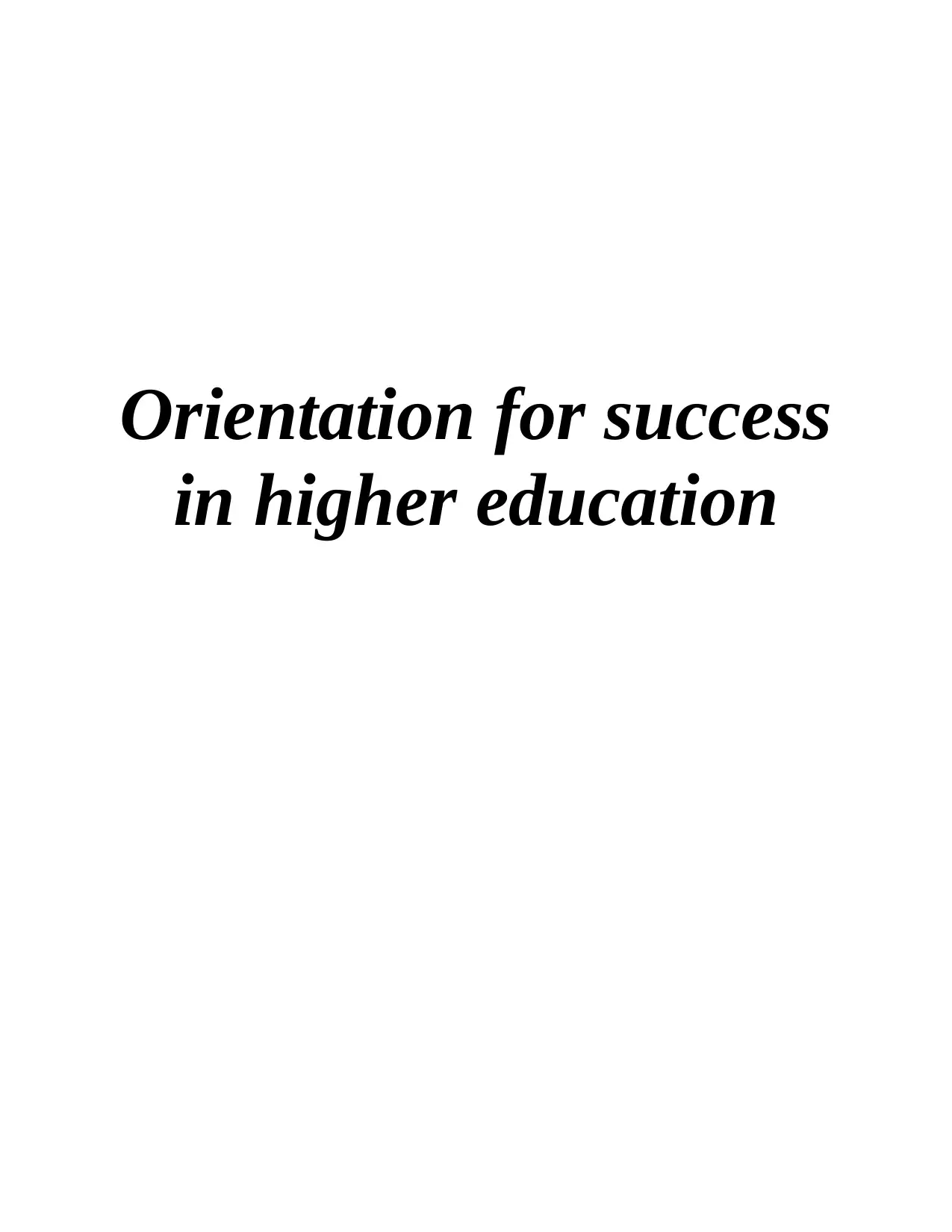
Orientation for success
in higher education
in higher education
Paraphrase This Document
Need a fresh take? Get an instant paraphrase of this document with our AI Paraphraser
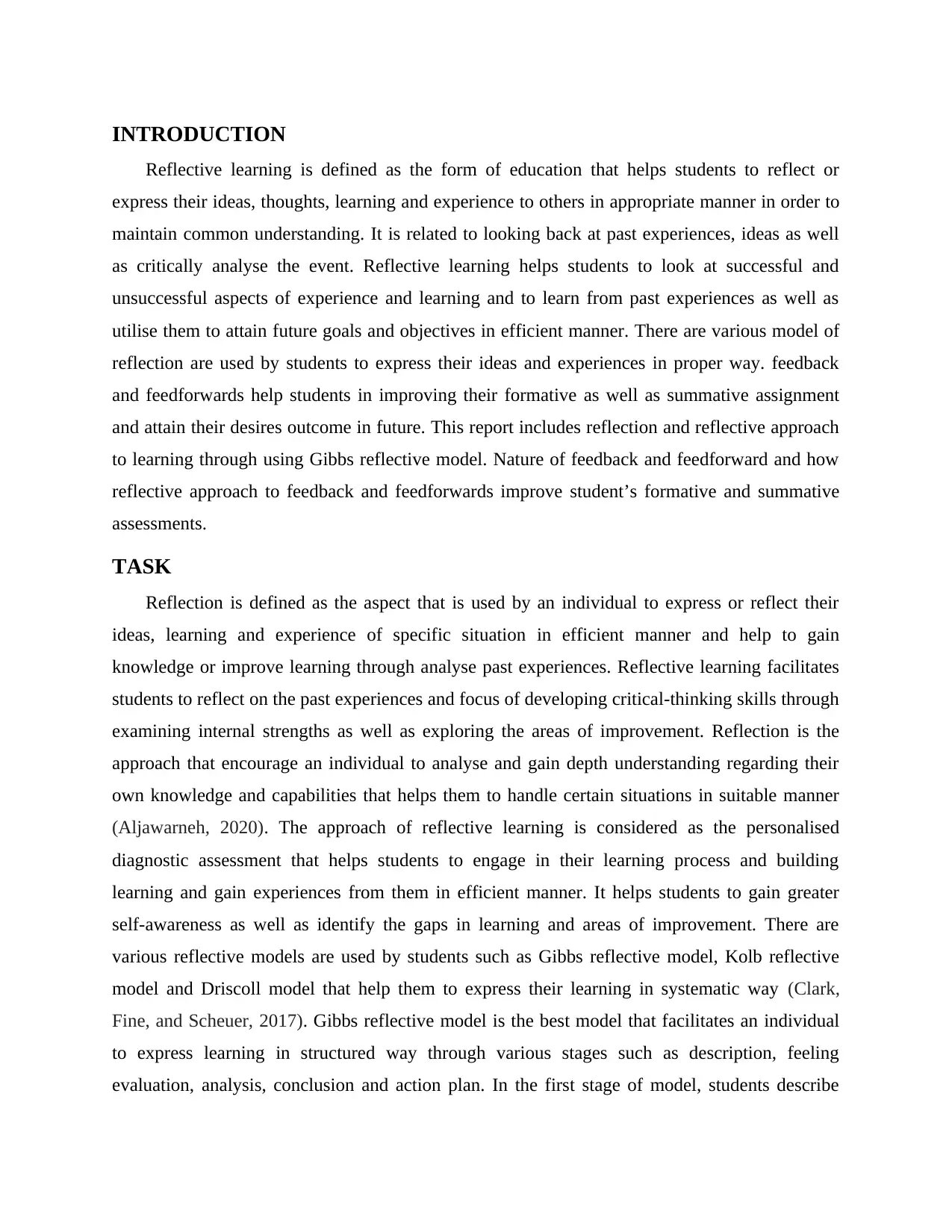
INTRODUCTION
Reflective learning is defined as the form of education that helps students to reflect or
express their ideas, thoughts, learning and experience to others in appropriate manner in order to
maintain common understanding. It is related to looking back at past experiences, ideas as well
as critically analyse the event. Reflective learning helps students to look at successful and
unsuccessful aspects of experience and learning and to learn from past experiences as well as
utilise them to attain future goals and objectives in efficient manner. There are various model of
reflection are used by students to express their ideas and experiences in proper way. feedback
and feedforwards help students in improving their formative as well as summative assignment
and attain their desires outcome in future. This report includes reflection and reflective approach
to learning through using Gibbs reflective model. Nature of feedback and feedforward and how
reflective approach to feedback and feedforwards improve student’s formative and summative
assessments.
TASK
Reflection is defined as the aspect that is used by an individual to express or reflect their
ideas, learning and experience of specific situation in efficient manner and help to gain
knowledge or improve learning through analyse past experiences. Reflective learning facilitates
students to reflect on the past experiences and focus of developing critical-thinking skills through
examining internal strengths as well as exploring the areas of improvement. Reflection is the
approach that encourage an individual to analyse and gain depth understanding regarding their
own knowledge and capabilities that helps them to handle certain situations in suitable manner
(Aljawarneh, 2020). The approach of reflective learning is considered as the personalised
diagnostic assessment that helps students to engage in their learning process and building
learning and gain experiences from them in efficient manner. It helps students to gain greater
self-awareness as well as identify the gaps in learning and areas of improvement. There are
various reflective models are used by students such as Gibbs reflective model, Kolb reflective
model and Driscoll model that help them to express their learning in systematic way (Clark,
Fine, and Scheuer, 2017). Gibbs reflective model is the best model that facilitates an individual
to express learning in structured way through various stages such as description, feeling
evaluation, analysis, conclusion and action plan. In the first stage of model, students describe
Reflective learning is defined as the form of education that helps students to reflect or
express their ideas, thoughts, learning and experience to others in appropriate manner in order to
maintain common understanding. It is related to looking back at past experiences, ideas as well
as critically analyse the event. Reflective learning helps students to look at successful and
unsuccessful aspects of experience and learning and to learn from past experiences as well as
utilise them to attain future goals and objectives in efficient manner. There are various model of
reflection are used by students to express their ideas and experiences in proper way. feedback
and feedforwards help students in improving their formative as well as summative assignment
and attain their desires outcome in future. This report includes reflection and reflective approach
to learning through using Gibbs reflective model. Nature of feedback and feedforward and how
reflective approach to feedback and feedforwards improve student’s formative and summative
assessments.
TASK
Reflection is defined as the aspect that is used by an individual to express or reflect their
ideas, learning and experience of specific situation in efficient manner and help to gain
knowledge or improve learning through analyse past experiences. Reflective learning facilitates
students to reflect on the past experiences and focus of developing critical-thinking skills through
examining internal strengths as well as exploring the areas of improvement. Reflection is the
approach that encourage an individual to analyse and gain depth understanding regarding their
own knowledge and capabilities that helps them to handle certain situations in suitable manner
(Aljawarneh, 2020). The approach of reflective learning is considered as the personalised
diagnostic assessment that helps students to engage in their learning process and building
learning and gain experiences from them in efficient manner. It helps students to gain greater
self-awareness as well as identify the gaps in learning and areas of improvement. There are
various reflective models are used by students such as Gibbs reflective model, Kolb reflective
model and Driscoll model that help them to express their learning in systematic way (Clark,
Fine, and Scheuer, 2017). Gibbs reflective model is the best model that facilitates an individual
to express learning in structured way through various stages such as description, feeling
evaluation, analysis, conclusion and action plan. In the first stage of model, students describe
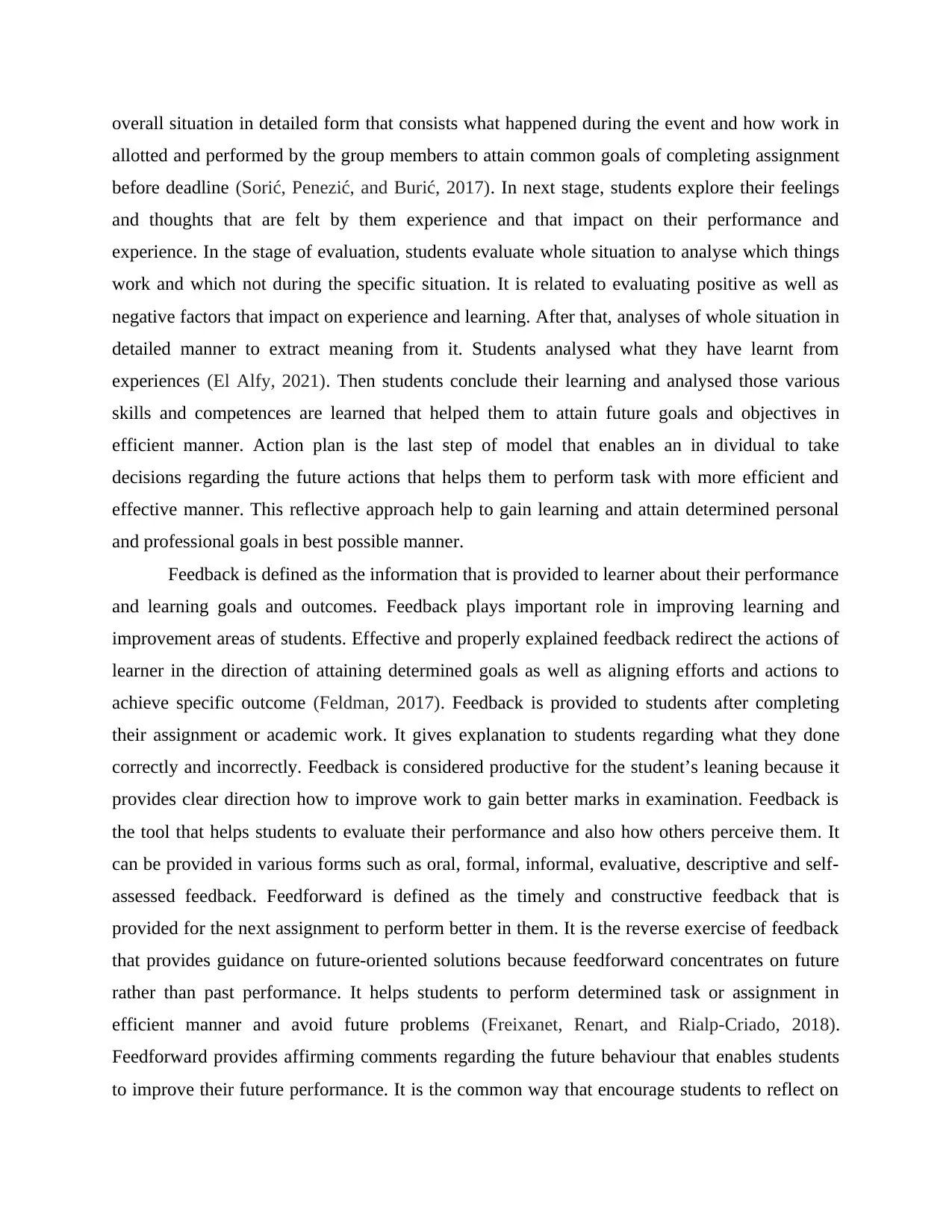
overall situation in detailed form that consists what happened during the event and how work in
allotted and performed by the group members to attain common goals of completing assignment
before deadline (Sorić, Penezić, and Burić, 2017). In next stage, students explore their feelings
and thoughts that are felt by them experience and that impact on their performance and
experience. In the stage of evaluation, students evaluate whole situation to analyse which things
work and which not during the specific situation. It is related to evaluating positive as well as
negative factors that impact on experience and learning. After that, analyses of whole situation in
detailed manner to extract meaning from it. Students analysed what they have learnt from
experiences (El Alfy, 2021). Then students conclude their learning and analysed those various
skills and competences are learned that helped them to attain future goals and objectives in
efficient manner. Action plan is the last step of model that enables an in dividual to take
decisions regarding the future actions that helps them to perform task with more efficient and
effective manner. This reflective approach help to gain learning and attain determined personal
and professional goals in best possible manner.
Feedback is defined as the information that is provided to learner about their performance
and learning goals and outcomes. Feedback plays important role in improving learning and
improvement areas of students. Effective and properly explained feedback redirect the actions of
learner in the direction of attaining determined goals as well as aligning efforts and actions to
achieve specific outcome (Feldman, 2017). Feedback is provided to students after completing
their assignment or academic work. It gives explanation to students regarding what they done
correctly and incorrectly. Feedback is considered productive for the student’s leaning because it
provides clear direction how to improve work to gain better marks in examination. Feedback is
the tool that helps students to evaluate their performance and also how others perceive them. It
can be provided in various forms such as oral, formal, informal, evaluative, descriptive and self-
assessed feedback. Feedforward is defined as the timely and constructive feedback that is
provided for the next assignment to perform better in them. It is the reverse exercise of feedback
that provides guidance on future-oriented solutions because feedforward concentrates on future
rather than past performance. It helps students to perform determined task or assignment in
efficient manner and avoid future problems (Freixanet, Renart, and Rialp-Criado, 2018).
Feedforward provides affirming comments regarding the future behaviour that enables students
to improve their future performance. It is the common way that encourage students to reflect on
allotted and performed by the group members to attain common goals of completing assignment
before deadline (Sorić, Penezić, and Burić, 2017). In next stage, students explore their feelings
and thoughts that are felt by them experience and that impact on their performance and
experience. In the stage of evaluation, students evaluate whole situation to analyse which things
work and which not during the specific situation. It is related to evaluating positive as well as
negative factors that impact on experience and learning. After that, analyses of whole situation in
detailed manner to extract meaning from it. Students analysed what they have learnt from
experiences (El Alfy, 2021). Then students conclude their learning and analysed those various
skills and competences are learned that helped them to attain future goals and objectives in
efficient manner. Action plan is the last step of model that enables an in dividual to take
decisions regarding the future actions that helps them to perform task with more efficient and
effective manner. This reflective approach help to gain learning and attain determined personal
and professional goals in best possible manner.
Feedback is defined as the information that is provided to learner about their performance
and learning goals and outcomes. Feedback plays important role in improving learning and
improvement areas of students. Effective and properly explained feedback redirect the actions of
learner in the direction of attaining determined goals as well as aligning efforts and actions to
achieve specific outcome (Feldman, 2017). Feedback is provided to students after completing
their assignment or academic work. It gives explanation to students regarding what they done
correctly and incorrectly. Feedback is considered productive for the student’s leaning because it
provides clear direction how to improve work to gain better marks in examination. Feedback is
the tool that helps students to evaluate their performance and also how others perceive them. It
can be provided in various forms such as oral, formal, informal, evaluative, descriptive and self-
assessed feedback. Feedforward is defined as the timely and constructive feedback that is
provided for the next assignment to perform better in them. It is the reverse exercise of feedback
that provides guidance on future-oriented solutions because feedforward concentrates on future
rather than past performance. It helps students to perform determined task or assignment in
efficient manner and avoid future problems (Freixanet, Renart, and Rialp-Criado, 2018).
Feedforward provides affirming comments regarding the future behaviour that enables students
to improve their future performance. It is the common way that encourage students to reflect on
⊘ This is a preview!⊘
Do you want full access?
Subscribe today to unlock all pages.

Trusted by 1+ million students worldwide
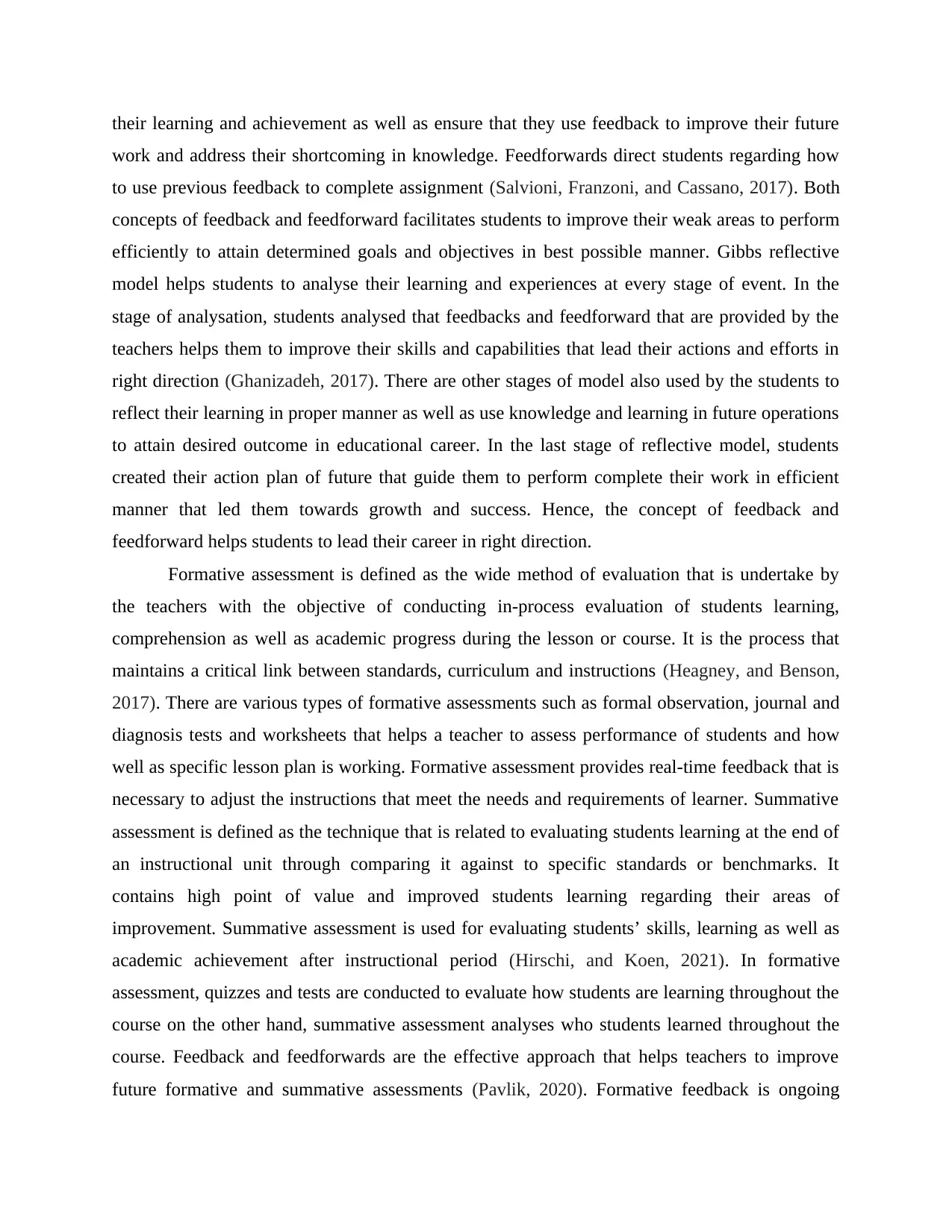
their learning and achievement as well as ensure that they use feedback to improve their future
work and address their shortcoming in knowledge. Feedforwards direct students regarding how
to use previous feedback to complete assignment (Salvioni, Franzoni, and Cassano, 2017). Both
concepts of feedback and feedforward facilitates students to improve their weak areas to perform
efficiently to attain determined goals and objectives in best possible manner. Gibbs reflective
model helps students to analyse their learning and experiences at every stage of event. In the
stage of analysation, students analysed that feedbacks and feedforward that are provided by the
teachers helps them to improve their skills and capabilities that lead their actions and efforts in
right direction (Ghanizadeh, 2017). There are other stages of model also used by the students to
reflect their learning in proper manner as well as use knowledge and learning in future operations
to attain desired outcome in educational career. In the last stage of reflective model, students
created their action plan of future that guide them to perform complete their work in efficient
manner that led them towards growth and success. Hence, the concept of feedback and
feedforward helps students to lead their career in right direction.
Formative assessment is defined as the wide method of evaluation that is undertake by
the teachers with the objective of conducting in-process evaluation of students learning,
comprehension as well as academic progress during the lesson or course. It is the process that
maintains a critical link between standards, curriculum and instructions (Heagney, and Benson,
2017). There are various types of formative assessments such as formal observation, journal and
diagnosis tests and worksheets that helps a teacher to assess performance of students and how
well as specific lesson plan is working. Formative assessment provides real-time feedback that is
necessary to adjust the instructions that meet the needs and requirements of learner. Summative
assessment is defined as the technique that is related to evaluating students learning at the end of
an instructional unit through comparing it against to specific standards or benchmarks. It
contains high point of value and improved students learning regarding their areas of
improvement. Summative assessment is used for evaluating students’ skills, learning as well as
academic achievement after instructional period (Hirschi, and Koen, 2021). In formative
assessment, quizzes and tests are conducted to evaluate how students are learning throughout the
course on the other hand, summative assessment analyses who students learned throughout the
course. Feedback and feedforwards are the effective approach that helps teachers to improve
future formative and summative assessments (Pavlik, 2020). Formative feedback is ongoing
work and address their shortcoming in knowledge. Feedforwards direct students regarding how
to use previous feedback to complete assignment (Salvioni, Franzoni, and Cassano, 2017). Both
concepts of feedback and feedforward facilitates students to improve their weak areas to perform
efficiently to attain determined goals and objectives in best possible manner. Gibbs reflective
model helps students to analyse their learning and experiences at every stage of event. In the
stage of analysation, students analysed that feedbacks and feedforward that are provided by the
teachers helps them to improve their skills and capabilities that lead their actions and efforts in
right direction (Ghanizadeh, 2017). There are other stages of model also used by the students to
reflect their learning in proper manner as well as use knowledge and learning in future operations
to attain desired outcome in educational career. In the last stage of reflective model, students
created their action plan of future that guide them to perform complete their work in efficient
manner that led them towards growth and success. Hence, the concept of feedback and
feedforward helps students to lead their career in right direction.
Formative assessment is defined as the wide method of evaluation that is undertake by
the teachers with the objective of conducting in-process evaluation of students learning,
comprehension as well as academic progress during the lesson or course. It is the process that
maintains a critical link between standards, curriculum and instructions (Heagney, and Benson,
2017). There are various types of formative assessments such as formal observation, journal and
diagnosis tests and worksheets that helps a teacher to assess performance of students and how
well as specific lesson plan is working. Formative assessment provides real-time feedback that is
necessary to adjust the instructions that meet the needs and requirements of learner. Summative
assessment is defined as the technique that is related to evaluating students learning at the end of
an instructional unit through comparing it against to specific standards or benchmarks. It
contains high point of value and improved students learning regarding their areas of
improvement. Summative assessment is used for evaluating students’ skills, learning as well as
academic achievement after instructional period (Hirschi, and Koen, 2021). In formative
assessment, quizzes and tests are conducted to evaluate how students are learning throughout the
course on the other hand, summative assessment analyses who students learned throughout the
course. Feedback and feedforwards are the effective approach that helps teachers to improve
future formative and summative assessments (Pavlik, 2020). Formative feedback is ongoing
Paraphrase This Document
Need a fresh take? Get an instant paraphrase of this document with our AI Paraphraser
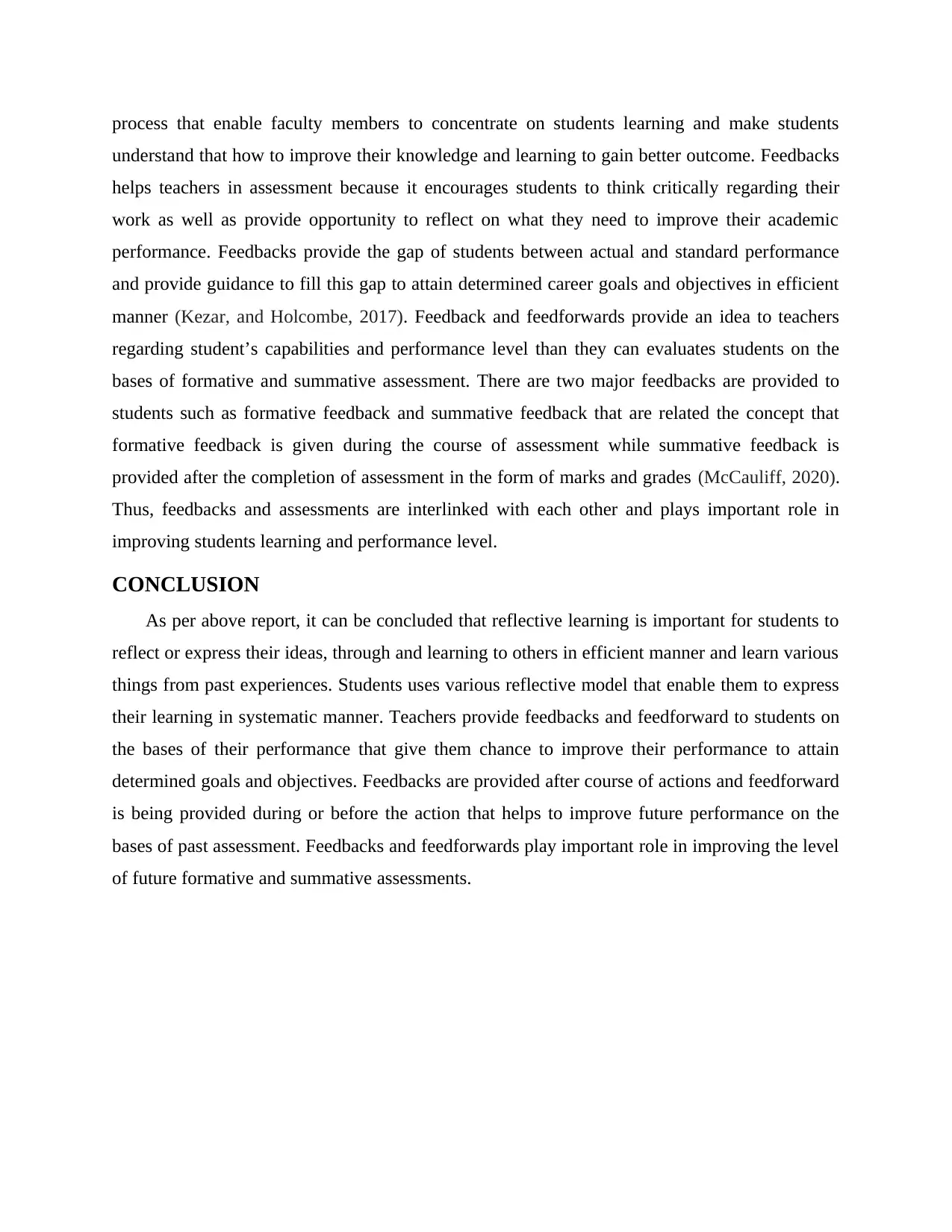
process that enable faculty members to concentrate on students learning and make students
understand that how to improve their knowledge and learning to gain better outcome. Feedbacks
helps teachers in assessment because it encourages students to think critically regarding their
work as well as provide opportunity to reflect on what they need to improve their academic
performance. Feedbacks provide the gap of students between actual and standard performance
and provide guidance to fill this gap to attain determined career goals and objectives in efficient
manner (Kezar, and Holcombe, 2017). Feedback and feedforwards provide an idea to teachers
regarding student’s capabilities and performance level than they can evaluates students on the
bases of formative and summative assessment. There are two major feedbacks are provided to
students such as formative feedback and summative feedback that are related the concept that
formative feedback is given during the course of assessment while summative feedback is
provided after the completion of assessment in the form of marks and grades (McCauliff, 2020).
Thus, feedbacks and assessments are interlinked with each other and plays important role in
improving students learning and performance level.
CONCLUSION
As per above report, it can be concluded that reflective learning is important for students to
reflect or express their ideas, through and learning to others in efficient manner and learn various
things from past experiences. Students uses various reflective model that enable them to express
their learning in systematic manner. Teachers provide feedbacks and feedforward to students on
the bases of their performance that give them chance to improve their performance to attain
determined goals and objectives. Feedbacks are provided after course of actions and feedforward
is being provided during or before the action that helps to improve future performance on the
bases of past assessment. Feedbacks and feedforwards play important role in improving the level
of future formative and summative assessments.
understand that how to improve their knowledge and learning to gain better outcome. Feedbacks
helps teachers in assessment because it encourages students to think critically regarding their
work as well as provide opportunity to reflect on what they need to improve their academic
performance. Feedbacks provide the gap of students between actual and standard performance
and provide guidance to fill this gap to attain determined career goals and objectives in efficient
manner (Kezar, and Holcombe, 2017). Feedback and feedforwards provide an idea to teachers
regarding student’s capabilities and performance level than they can evaluates students on the
bases of formative and summative assessment. There are two major feedbacks are provided to
students such as formative feedback and summative feedback that are related the concept that
formative feedback is given during the course of assessment while summative feedback is
provided after the completion of assessment in the form of marks and grades (McCauliff, 2020).
Thus, feedbacks and assessments are interlinked with each other and plays important role in
improving students learning and performance level.
CONCLUSION
As per above report, it can be concluded that reflective learning is important for students to
reflect or express their ideas, through and learning to others in efficient manner and learn various
things from past experiences. Students uses various reflective model that enable them to express
their learning in systematic manner. Teachers provide feedbacks and feedforward to students on
the bases of their performance that give them chance to improve their performance to attain
determined goals and objectives. Feedbacks are provided after course of actions and feedforward
is being provided during or before the action that helps to improve future performance on the
bases of past assessment. Feedbacks and feedforwards play important role in improving the level
of future formative and summative assessments.

⊘ This is a preview!⊘
Do you want full access?
Subscribe today to unlock all pages.

Trusted by 1+ million students worldwide
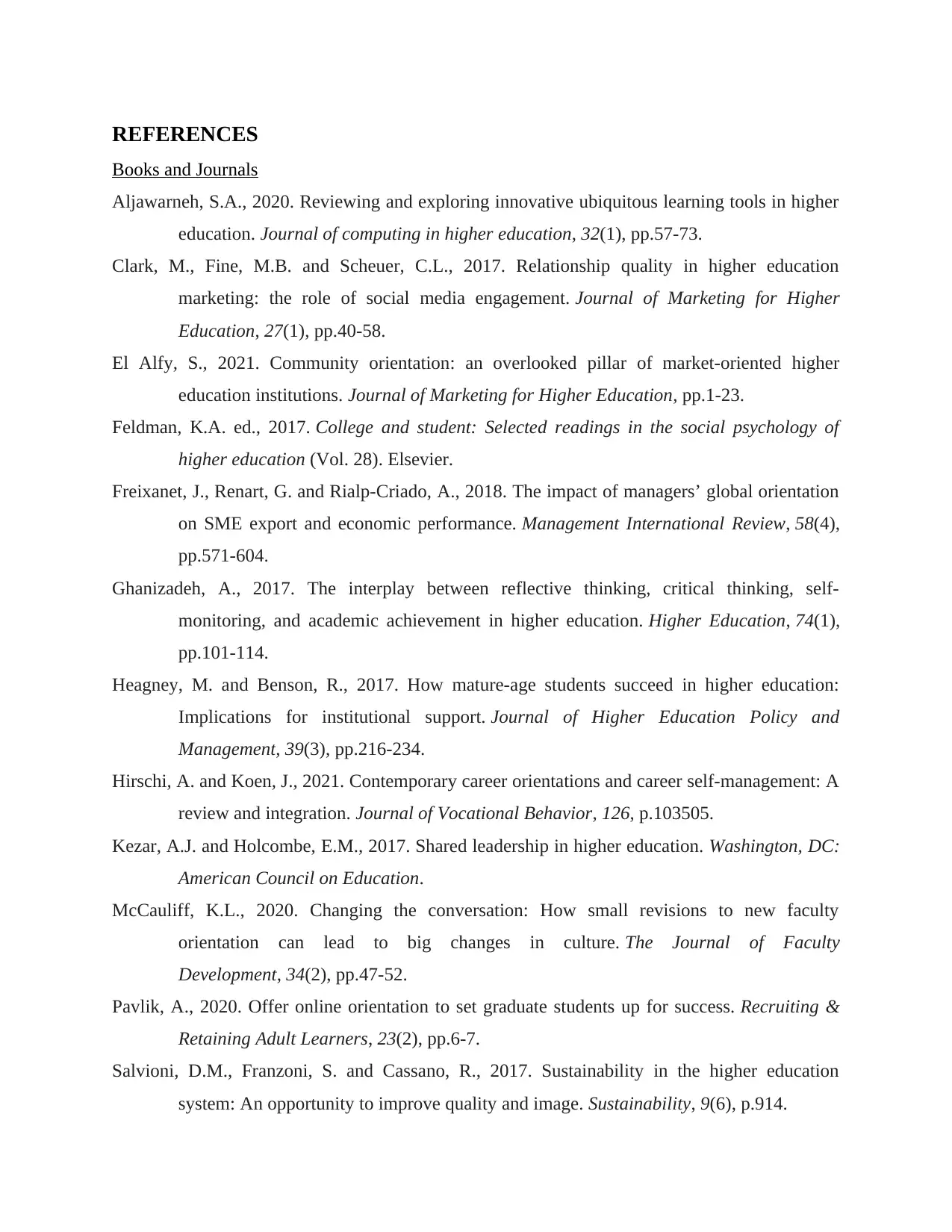
REFERENCES
Books and Journals
Aljawarneh, S.A., 2020. Reviewing and exploring innovative ubiquitous learning tools in higher
education. Journal of computing in higher education, 32(1), pp.57-73.
Clark, M., Fine, M.B. and Scheuer, C.L., 2017. Relationship quality in higher education
marketing: the role of social media engagement. Journal of Marketing for Higher
Education, 27(1), pp.40-58.
El Alfy, S., 2021. Community orientation: an overlooked pillar of market-oriented higher
education institutions. Journal of Marketing for Higher Education, pp.1-23.
Feldman, K.A. ed., 2017. College and student: Selected readings in the social psychology of
higher education (Vol. 28). Elsevier.
Freixanet, J., Renart, G. and Rialp-Criado, A., 2018. The impact of managers’ global orientation
on SME export and economic performance. Management International Review, 58(4),
pp.571-604.
Ghanizadeh, A., 2017. The interplay between reflective thinking, critical thinking, self-
monitoring, and academic achievement in higher education. Higher Education, 74(1),
pp.101-114.
Heagney, M. and Benson, R., 2017. How mature-age students succeed in higher education:
Implications for institutional support. Journal of Higher Education Policy and
Management, 39(3), pp.216-234.
Hirschi, A. and Koen, J., 2021. Contemporary career orientations and career self-management: A
review and integration. Journal of Vocational Behavior, 126, p.103505.
Kezar, A.J. and Holcombe, E.M., 2017. Shared leadership in higher education. Washington, DC:
American Council on Education.
McCauliff, K.L., 2020. Changing the conversation: How small revisions to new faculty
orientation can lead to big changes in culture. The Journal of Faculty
Development, 34(2), pp.47-52.
Pavlik, A., 2020. Offer online orientation to set graduate students up for success. Recruiting &
Retaining Adult Learners, 23(2), pp.6-7.
Salvioni, D.M., Franzoni, S. and Cassano, R., 2017. Sustainability in the higher education
system: An opportunity to improve quality and image. Sustainability, 9(6), p.914.
Books and Journals
Aljawarneh, S.A., 2020. Reviewing and exploring innovative ubiquitous learning tools in higher
education. Journal of computing in higher education, 32(1), pp.57-73.
Clark, M., Fine, M.B. and Scheuer, C.L., 2017. Relationship quality in higher education
marketing: the role of social media engagement. Journal of Marketing for Higher
Education, 27(1), pp.40-58.
El Alfy, S., 2021. Community orientation: an overlooked pillar of market-oriented higher
education institutions. Journal of Marketing for Higher Education, pp.1-23.
Feldman, K.A. ed., 2017. College and student: Selected readings in the social psychology of
higher education (Vol. 28). Elsevier.
Freixanet, J., Renart, G. and Rialp-Criado, A., 2018. The impact of managers’ global orientation
on SME export and economic performance. Management International Review, 58(4),
pp.571-604.
Ghanizadeh, A., 2017. The interplay between reflective thinking, critical thinking, self-
monitoring, and academic achievement in higher education. Higher Education, 74(1),
pp.101-114.
Heagney, M. and Benson, R., 2017. How mature-age students succeed in higher education:
Implications for institutional support. Journal of Higher Education Policy and
Management, 39(3), pp.216-234.
Hirschi, A. and Koen, J., 2021. Contemporary career orientations and career self-management: A
review and integration. Journal of Vocational Behavior, 126, p.103505.
Kezar, A.J. and Holcombe, E.M., 2017. Shared leadership in higher education. Washington, DC:
American Council on Education.
McCauliff, K.L., 2020. Changing the conversation: How small revisions to new faculty
orientation can lead to big changes in culture. The Journal of Faculty
Development, 34(2), pp.47-52.
Pavlik, A., 2020. Offer online orientation to set graduate students up for success. Recruiting &
Retaining Adult Learners, 23(2), pp.6-7.
Salvioni, D.M., Franzoni, S. and Cassano, R., 2017. Sustainability in the higher education
system: An opportunity to improve quality and image. Sustainability, 9(6), p.914.
Paraphrase This Document
Need a fresh take? Get an instant paraphrase of this document with our AI Paraphraser
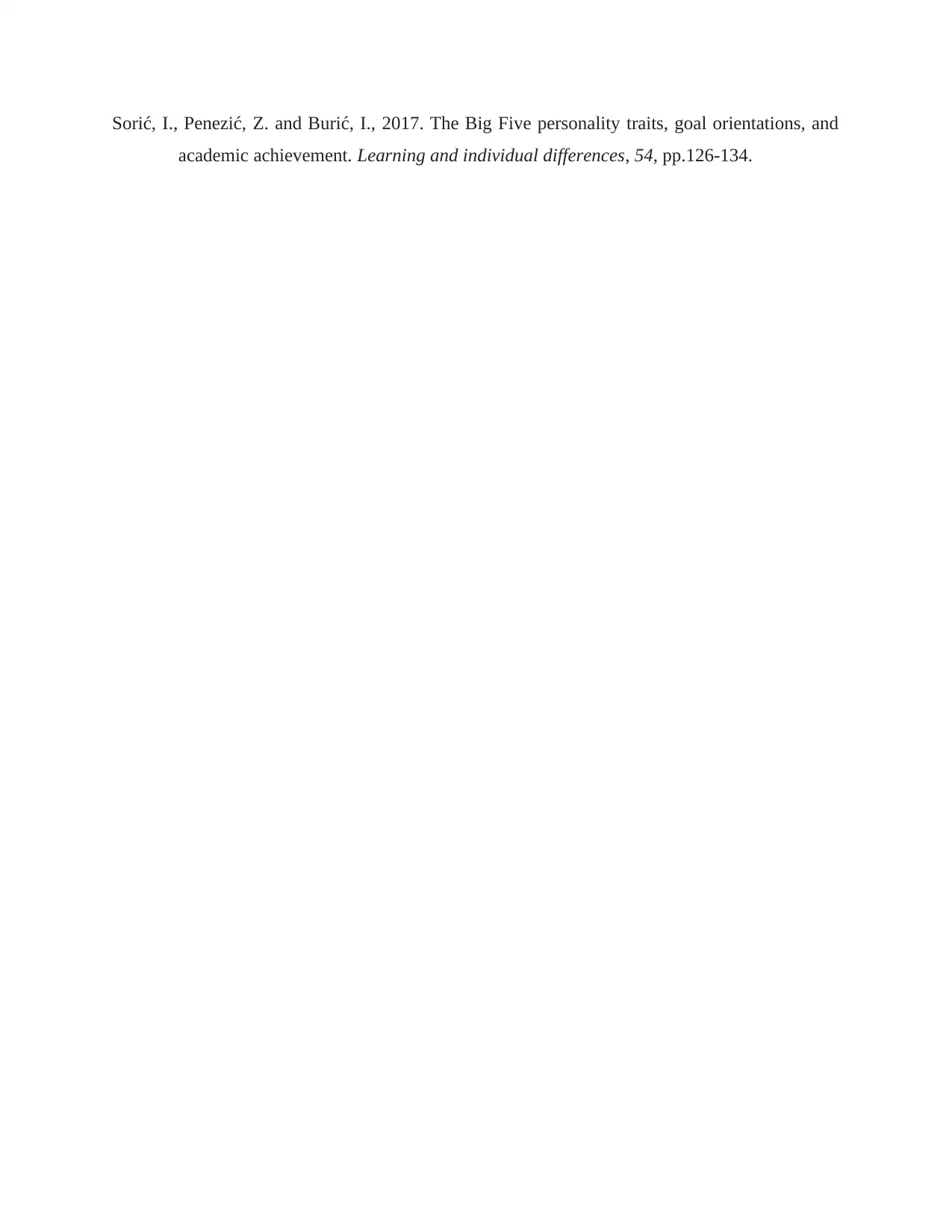
Sorić, I., Penezić, Z. and Burić, I., 2017. The Big Five personality traits, goal orientations, and
academic achievement. Learning and individual differences, 54, pp.126-134.
academic achievement. Learning and individual differences, 54, pp.126-134.
1 out of 8
Related Documents
Your All-in-One AI-Powered Toolkit for Academic Success.
+13062052269
info@desklib.com
Available 24*7 on WhatsApp / Email
![[object Object]](/_next/static/media/star-bottom.7253800d.svg)
Unlock your academic potential
Copyright © 2020–2025 A2Z Services. All Rights Reserved. Developed and managed by ZUCOL.

